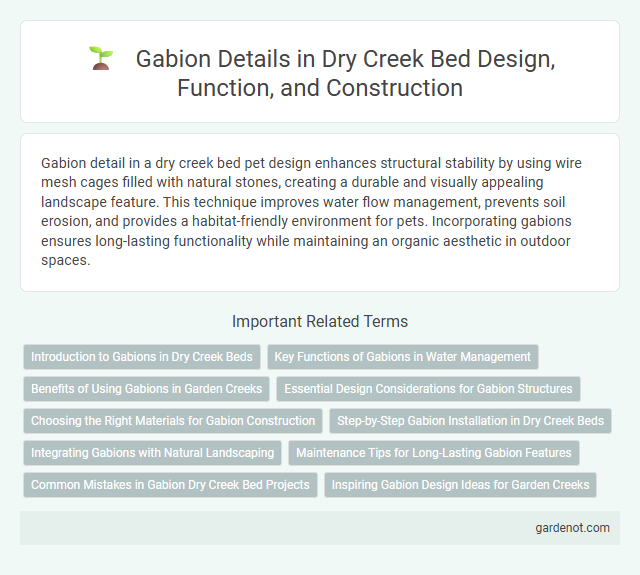Gabion detail in a dry creek bed pet design enhances structural stability by using wire mesh cages filled with natural stones, creating a durable and visually appealing landscape feature. This technique improves water flow management, prevents soil erosion, and provides a habitat-friendly environment for pets. Incorporating gabions ensures long-lasting functionality while maintaining an organic aesthetic in outdoor spaces.
Introduction to Gabions in Dry Creek Beds
Gabions consist of wire mesh containers filled with rocks or stones, specifically designed to stabilize dry creek beds and prevent erosion. These structures allow water to flow freely while supporting soil retention, making them ideal for managing stormwater runoff and protecting creek banks. Their durability and permeability make gabions a sustainable solution for enhancing the structural integrity of dry creek environments.
Key Functions of Gabions in Water Management
Gabions serve crucial functions in water management by stabilizing dry creek beds through erosion control and slope reinforcement, effectively preventing soil loss during intermittent water flow. Their porous structure allows efficient drainage, reducing hydrostatic pressure and promoting groundwater recharge while filtering sediment. Constructed from wire mesh filled with stones, gabions provide durable, flexible barriers that adapt to shifting creek dynamics and mitigate flood damage.
Benefits of Using Gabions in Garden Creeks
Gabions provide effective erosion control and structural stability in dry creek beds by retaining soil and managing water flow. Their porous design allows natural drainage while supporting plant growth, enhancing the ecological balance of garden creeks. Gabions are also durable and low-maintenance, making them a practical choice for long-term landscape projects.
Essential Design Considerations for Gabion Structures
Gabion structures in dry creek beds require precise attention to mesh size, wire gauge, and stone infill quality to ensure durability and permeability. Proper foundation preparation and drainage design are critical to prevent erosion and structural failure under fluctuating water flows. Incorporating flexible joints and appropriate slope angles enhances stability while accommodating natural creek bed dynamics.
Choosing the Right Materials for Gabion Construction
Selecting the right materials for gabion construction in a dry creek bed involves using galvanized or PVC-coated steel wire to ensure corrosion resistance and longevity. The filling material typically consists of angular, durable stones that resist erosion and maintain structural integrity under water flow fluctuations. Proper mesh size and stone gradation must be matched to prevent stone displacement while allowing adequate drainage.
Step-by-Step Gabion Installation in Dry Creek Beds
Step-by-step gabion installation in dry creek beds begins with site preparation, including clearing debris and leveling the ground to ensure stability. Next, assemble gabion baskets by connecting wire mesh panels securely and filling them with locally sourced rocks or stones to promote natural water flow and erosion control. Finally, position gabions along the creek bed, stacking them as needed, and backfill with soil or gravel to enhance structural integrity and support vegetation growth.
Integrating Gabions with Natural Landscaping
Gabions, wire mesh cages filled with rocks, provide effective erosion control and structural support in dry creek beds while blending seamlessly with natural surroundings. These structures promote water flow management and enhance habitat creation by incorporating native stones and vegetation within and around the gabions. Using gabions aligned with the creek's natural contours supports sustainability and aesthetic harmony in landscape design.
Maintenance Tips for Long-Lasting Gabion Features
Regular inspection of gabion structures in dry creek beds is essential to identify any signs of wire corrosion or displacement of stones. Clearing debris and vegetation buildup prevents water flow obstruction and reduces pressure on the gabion baskets. Applying protective coatings and promptly repairing damaged sections ensures the durability and structural integrity of gabion features.
Common Mistakes in Gabion Dry Creek Bed Projects
Common mistakes in gabion dry creek bed projects include improper wire mesh selection, leading to premature corrosion and structural failure. Insufficient anchoring and poor foundation preparation cause shifting and settling over time, compromising stability. Neglecting adequate drainage design results in water pooling, which accelerates erosion and damages the gabion baskets.
Inspiring Gabion Design Ideas for Garden Creeks
Gabion baskets filled with natural stones create durable, permeable retaining walls that enhance the aesthetic of dry creek beds in gardens. Incorporating varying sizes and shapes of gabions allows for natural water flow management while adding texture and visual interest to the landscape. Strategic placement of gabions along gentle slopes promotes soil stabilization and supports native plant growth, blending functionality with eco-friendly design.
Gabion detail Infographic

 gardenot.com
gardenot.com